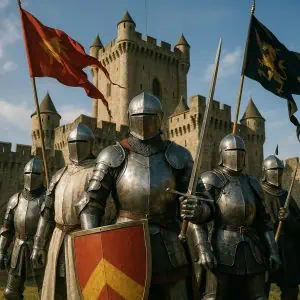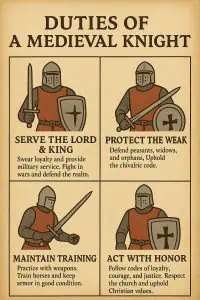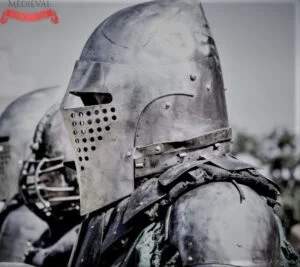Medieval knights were elite warriors and highly respected members of feudal society. Their lives revolved around a strict code of chivalry, extensive martial training, and dedicated service to their lord or king. Knights were trained from a young age to master swordsmanship, horsemanship, and battlefield strategy, while also upholding honor, loyalty, and courage. As symbols of strength and nobility, medieval knights played a crucial role in warfare, tournaments, and the protection of their lands and people.

Let’s explore the first section of the daily life of a medieval knight, focusing on their family and personal life, recreational pursuits, work responsibilities, and means of providing for their families.
“A medieval knight’s life was a tapestry of rigorous training, noble responsibilities, and daring quests. Embodying the virtues of chivalry, they strived to uphold honor, loyalty, and valor in a world where their actions on and off the battlefield defined their legacy.”
Dr. Eleanor Marshall, Medieval Historian.
Family Life
The knight’s family played a crucial role in their personal life. They typically lived in fortified manor houses or castles, surrounded by their immediate and extended family. Knights married noblewomen, forming alliances and strengthening their social status. They were expected to fulfill their duties as husbands and fathers, ensuring the continuation of their family line and inheritance.

Recreation
Knights, when not engaged in military campaigns or training, indulged in various recreational activities to demonstrate their skill and prowess.
Tournaments and jousting events were central to knightly entertainment, allowing them to showcase their martial abilities and engage in friendly competition.
Hunting was also a popular pastime among knights, providing an opportunity for leisure and displaying their expertise in tracking and falconry.

Religious Observance
Knights, deeply rooted in Christian beliefs, held a strong connection to the Church. They regularly attended religious services, offering prayers for guidance and protection in their knightly pursuits.
Knights often sought the guidance of religious figures, such as priests or monks, and participated in pilgrimages to sacred sites.
Work Responsibilities
A knight’s primary responsibility was to serve their lord and fulfill their military obligations. They fought on behalf of their lord in times of war, engaging in battles and sieges. Knights also performed duties such as guarding the lord’s lands, enforcing laws, and maintaining order within the domain.

Training in martial arts, horsemanship, and weaponry consumed a significant portion of their time to ensure their combat readiness.
Compensation and Income
Unlike serfs, knights received compensation for their service. They were granted land and estates by their lord, known as a fief, in exchange for their military service and loyalty. This land provided the knight with income, which could be generated through various means, including agriculture, rents from tenants, or tribute from peasants.

Knights also had the opportunity to acquire wealth through ransom, plunder, or marriage into wealthy families.
Providing for the Family
Knights were responsible for providing for their families’ needs, ensuring their well-being and social status. The income derived from their land and estates supported their lifestyle, enabling them to maintain a retinue of servants, armor, weapons, and fine attire.
Knights also aimed to secure advantageous marriages for their children, further strengthening their family’s position within the noble hierarchy.

The daily life of a medieval knight was deeply intertwined with their family, chivalric pursuits, and military obligations. Knights engaged in recreational activities that showcased their martial prowess, participated in religious observances, and upheld the code of chivalry.
“Beyond the glint of their armor, the daily life of a medieval knight involved a delicate balance of military prowess and courtly etiquette. Whether in combat or in leisure, they navigated the complexities of their era, leaving behind a romanticized legacy that still captivates our imaginations.”
Professor Henry Morgan, Medieval Studies Scholar.
Their compensation, in the form of land and income, supported their lifestyle and allowed them to provide for their families. In the next section, we will explore the knight’s role in the feudal hierarchy and their interactions with other members of society.
Daily Life of a Medieval Knights
“Life in a Medieval Castle” by Joseph Gies and Frances Gies
This book provides a comprehensive look at the daily routines, responsibilities, and social customs of knights and other inhabitants of medieval castles.
“Knight: The Medieval Warrior’s (Unofficial) Manual” by Michael Prestwich
Offering an engaging and practical perspective, this book takes readers on a journey through a knight’s daily life, covering training, combat, courtly love, and the intricacies of chivalry.
“A Knight’s Own Book of Chivalry” by Geoffroi de Charny
This book is a treatise written by a knight from the late 14th century, offering a firsthand account of the chivalric ideals and practices followed by medieval knights.
“Chivalry: The Path of Love” by Michael M. Nikitin
This book explores the concept of chivalry and how it influenced the daily life, values, and actions of medieval knights.
“The Time Traveler’s Guide to Medieval England: A Handbook for Visitors to the Fourteenth Century” by Ian Mortimer
Though not exclusively focused on knights, this book provides an immersive experience of medieval life, including knights, through the eyes of a hypothetical time traveler.
These books collectively paint a vivid picture of a medieval knight’s daily existence, offering historical context, cultural insights, and a glimpse into the world of chivalry and honor.
What did a typical day for a medieval knight involve?
A typical day included **training in combat**, maintaining armor and weapons, attending to duties for their lord, and participating in court or religious activities.
How did knights spend their free time?
Knights often spent free time practicing **hunting**, engaging in **tournaments**, studying strategy, or socializing at court.
What kind of training did medieval knights undergo?
Knights trained from a young age in **swordsmanship, jousting, horsemanship**, and battlefield tactics, first as pages and squires.
Did knights have specific meals or diets?
Knights typically ate **meat, bread, and ale**, with meals designed to sustain energy for **physical training** and combat.
Where did knights live?
Knights usually lived in **castles** or **manor houses** provided by their lord, with quarters for themselves, their squires, and servants.
What role did religion play in a knight’s daily life?
Religion was central; knights often attended **church services**, prayed before battles, and followed the **moral expectations** of the Church.
Did knights participate in entertainment?
Yes, they enjoyed **feasts, tournaments, music, and storytelling**, which were important for social status and morale.
How much free time did knights really have?
Free time was limited; most time was spent in **training, managing estates**, or fulfilling obligations to their lord.
Did knights have personal servants?
Yes, knights often had **squires and servants** to help with armor, horses, and daily tasks, allowing them to focus on training and duty.
Were daily lives different during peacetime vs. wartime?
During wartime, knights spent most of their days **preparing for and engaging in battles**, whereas peacetime focused on **training, managing lands**, and ceremonial duties.






